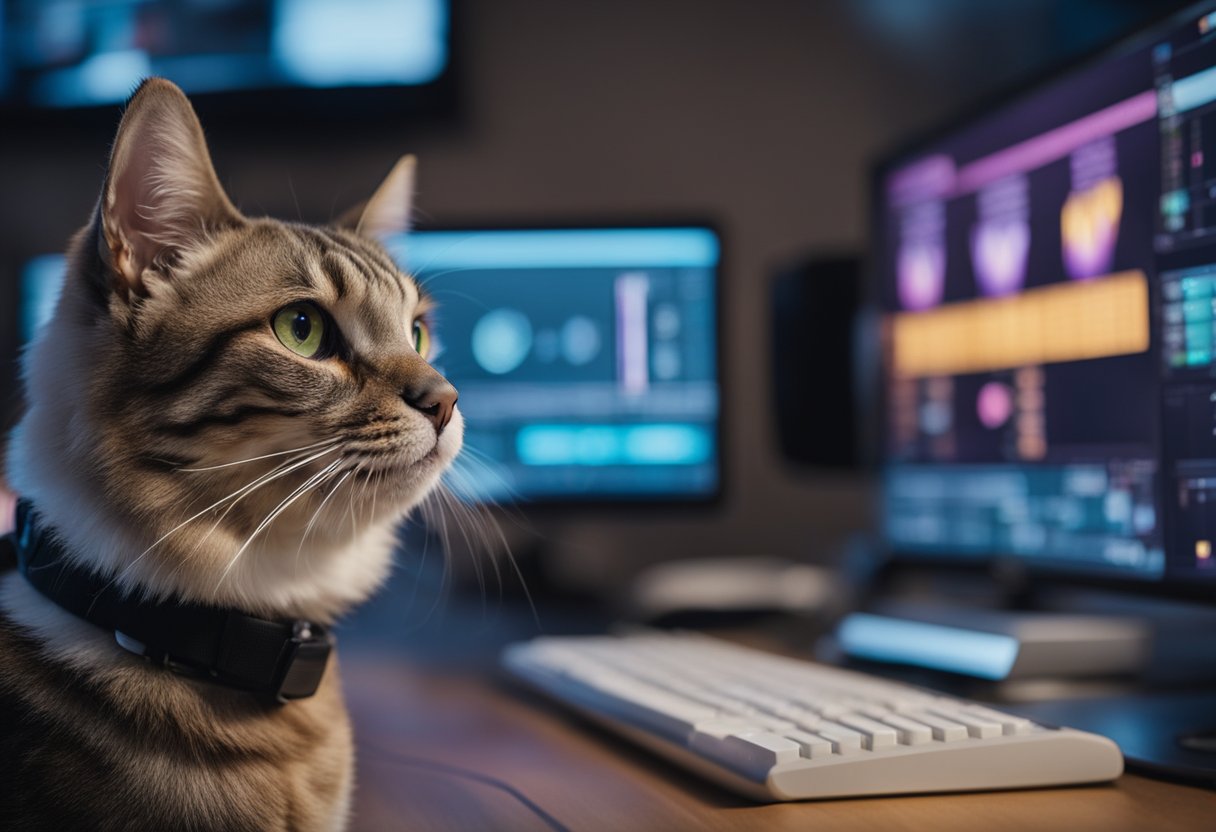Ever wondered what your pet is trying to tell you with their barks, meows, or chirps? With advancements in technology, we’re now closer than ever to understanding the rich tapestry of animal communication. Our furry friends convey a wide array of emotions through their unique vocal patterns—distress, contentment, curiosity, and more. Artificial intelligence is proving to be a game-changer, giving us the tools to interpret these vocalizations.
We’re not just relying on instinct or guesswork anymore; AI is helping us make sense of complex pet sounds. This technology doesn’t just decode what these sounds mean; it opens up a whole new world of understanding between humans and animals. By analyzing vocal cues, AI empowers us to respond to our pets’ needs more effectively and to develop stronger, more nurturing relationships with them.
Key Takeaways
- AI technology is enhancing our understanding of pet communications.
- Deciphering pet vocalizations leads to stronger human-animal bonds.
- This innovation aids in addressing the emotional and behavioral needs of pets.
Evolution of Pet Communication
We’ve always been fascinated by what our pets are trying to tell us. Today, we’re on the cusp of using AI to make sense of those barks and purrs, bridging the only gap that’s kept us from deeper bonds with our animal companions.
Historical Perspectives
The journey to understand pet communication is not a new endeavor. Historically, our methods were observational, limited to what we could infer from behavior and sounds. Our ancestors interpreted animals’ needs based on repetition and context, recognizing patterns in vocalizations when pets were hungry, threatened, or seeking attention. As the years passed, we began to document these observations, leading to an initial framework for understanding pet language—albeit through our human lens.
Comparative Analysis of Different Species
Every animal has its dialect: dogs bark and whine, cats meow and purr, and birds chirp and sing. The development of AI in understanding these species’ sounds has shown that not all vocalizations are created equal. Technologies are being tailored to recognize specific frequencies and patterns unique to each species. Dogs, for instance, communicate emotional states through a variety of barks, each with distinct pitch and duration. On the other hand, cats convey a wide range of messages in their meows, with subtle tone variations signaling everything from contentment to stress. Through a comparative analysis, AI not only delineates these differences but also starts to build a ‘vocabulary’ we can interpret.
The Role of AI in Pet Vocalization Analysis
Artificial Intelligence (AI) is proving to be invaluable in bridging the communication gap between us and our pets. By analyzing and interpreting the various sounds our pets make, AI enables us to better understand their needs and emotions.
Current Technologies in Use
Today, customized AI solutions are actively used in discerning pet sounds, with devices that can analyze vocal cues and translate them into human-readable information. This technology not only identifies common patterns in pet vocalizations but also is tailoring interactions to the individual characteristics of each pet. For instance, an AI system might pick up on the unique pitch or pattern of a dog’s bark and, over time, determine if it’s indicative of excitement, fear, or hunger.
Methodologies for Sound Recognition
Methodologically, these AI systems employ advanced algorithms such as machine learning and neural networks to learn from vast datasets of animal sounds. After training the AI with these datasets, it is capable of comparing and contrasting new vocal samples with learned patterns to recognize specific alerts or states of being in our pets. Feline vocalization analysis, for example, may reveal different types of meows that correspond to complex states like stress or contentment.
Challenges and Limitations
Despite remarkable advancements, we face challenges in this field. Accuracy and the potential for misinterpretation are at the forefront of these challenges, as the AI must navigate the nuanced differences in pet vocalizations. Furthermore, there are limitations in terms of lack of data for rare breeds or mixed-breed animals, which might not follow the established models of purebreds. Also, ensuring that these technologies are accessible and user-friendly for all pet owners is a priority that we are still working to address.
Understanding Canine Vocalizations

As pet owners, we’ve all been there—your dog barks, whines, or growls, and you’re left wondering what they’re trying to say. With the help of AI, we’re now on the cusp of truly understanding the nuances of these sounds. It’s an exciting development that promises to bring us closer to our furry friends.
Barks, Whines, and Growls
Barks: Every dog’s bark is as unique as a fingerprint, conveying emotions from joy to distress. High-pitched barks often indicate excitement or a call for attention, while lower-pitched tones can signify a threat or a warning.
- Excitement: High-pitched, rapid barks
- Alertness: Sharp, short barks
- Aggression: Low-pitched, slow barks
Whines and Whimpers: These sounds are typically associated with desires or emotional states such as hunger, stress, or the need for companionship. Puppies, especially, will use these sounds to express their needs to their mothers.
- Desire for attention: High-pitched, sustained whines
- Discomfort or distress: Lower, softer whines
Growls: Though often perceived as aggressive, growls can also be playful. It’s the context that determines the message. A growl during playtime is much different than one directed at a stranger invading your dog’s space.
- Playfulness: Soft, short growls during play
- Warning: Deep, prolonged growls when threatened
Contextual Interpretation of Sounds
Identifying the context in which a sound is made is essential for accurate interpretation. The same bark can have multiple meanings depending on the situation, body language, and even the dog’s breed.
- Situation: Are they alone or with other dogs? Is there a new person in the room?
- Body Language: Is the tail wagging or are the ears pinned back?
- Breed Specifics: Some breeds tend to be more vocal, while others are quieter.
AI algorithms have been honed to factor in these variables, offering us a much clearer understanding of what our dogs are attempting to communicate. For example, projects like Zoolingua seek to decode and translate dog vocalizations into human-understandable messages through AI and machine learning.
Decoding Feline Meows

We’ve all been intrigued by our feline companions’ vocal stylings, but did you know artificial intelligence can now help us understand what each meow might mean? With tools that analyze cat vocalizations, we’re uncovering the rich tapestry of meows, each with its own distinct meaning. Let’s explore how variations in meows relate to different behaviors.
Variations in Cat Vocalizations
Cats have a diverse vocal repertoire, each serving a unique purpose. Vocalizations vary widely between individual cats, but some common patterns have been observed:
- Short, high-pitched meow: Often a greeting or a request for attention.
- Prolonged meow: Can indicate distress or a demanding tone.
- Low-pitch meow: Might signify annoyance or displeasure.
- Chatter: Typically occurs when a cat is watching birds or other prey animals.
By utilizing AI technology, we are now able to analyze these sounds and match them with behavioral cues to better understand our cat’s communication.
Behavioral Correlates of Meows
The behavior associated with meows can be just as important as the sound itself:
- Greeting: A short, cheerful meow as you come home can signal a friendly hello.
- Hunger: Repetitive meows might be a reminder that it’s time for a meal.
- Stress: A series of loud meows could be a sign of stress or discomfort.
- Playfulness: Soft, almost conversational meows can mean your cat is in a playful mood.
By recognizing these vocal cues and their associated behaviors, we establish a deeper bond with our pets. The use of AI has been groundbreaking, making such insights into cat behavior possible.
Applications and Benefits

We’ve seen exciting breakthroughs in how AI can interpret the complex vocalizations of our furry friends, leading to better understanding and care. Let’s dive into the specific applications and benefits this technology brings to our lives and the lives of our pets.
Improving Human-Pet Communication
AI-powered tools are now able to translate our pets’ sounds into something we can understand. Apps like MeowTalk demonstrate this by identifying emotional states in cats’ meows with notable accuracy. For us pet owners, this means we can finally get a glimpse into what our cats may be trying to convey, whether they’re feeling content, stressed, or in need of attention.
Health Monitoring and Welfare
Not only does AI assist in everyday communication with pets, but it also plays a critical role in monitoring their health. AI systems can detect subtle changes in our pets’ vocalizations, which may be early signs of distress or illness. For instance, changes in a cat’s meow pitch could hint at pain, which AI can help us to recognize and address sooner for their well-being. This leads to more proactive healthcare, ensuring our pets stay happy and healthy for as long as possible.
Frequently Asked Questions
We’ve all been curious at some point what our pets are trying to tell us with their varied sounds. Advances in artificial intelligence have opened up exciting possibilities, allowing us to get closer to understanding the emotions and needs communicated through our pets’ vocalizations.
How does artificial intelligence contribute to translating animal vocalizations?
AI leverages machine learning algorithms to analyze the patterns and frequencies of animal sounds, identifying nuances that point to specific behaviors or states of well-being. For example, recent tech developments have made it possible for customized AI solutions to help pet owners interpret their pets’ vocal cues with greater precision.
What advancements have been made in AI for understanding animal communication?
Breakthroughs in AI have led to technologies that can begin to interpret the complex languages of animals. Research on sperm whale communication is an example, where AI algorithms are applied to decipher the meaning behind the whales’ click patterns.
Can AI applications translate my pet’s sounds into human language?
While AI doesn’t yet offer a direct translation of pet sounds to human language, it does provide insights. AI-enabled tools can analyze your pet’s vocalizations, giving you a better understanding of whether a meow, bark, or chirp might indicate contentment, distress, or something in their environment that needs attention.
What are the benefits of using AI to interpret the sounds made by pets?
AI interpretation of pet sounds can enhance the bond between you and your animal companions by tailoring care to their emotional states and fostering improved communication. It can also alert owners to potential health issues that may be indicated by a change in vocalizations, thus enabling proactive care.
In what ways is AI being utilized to facilitate conversations between humans and animals?
AI is currently being used to analyze and categorize animal sounds, thereby helping humans to respond appropriately to their needs. For instance, researchers are employing AI to unlock the emotional states conveyed by cat vocalizations, which can be quite complex.
Are there any AI tools available that can help pet owners understand their pets’ emotions and needs?
Absolutely, there are various AI tools and applications available today that assist pet owners in interpreting their pets’ behaviors and vocalizations. These tools can offer clues to pets’ emotional well-being and provide guidance on how to better meet their companions’ needs, enhancing overall pet care.

